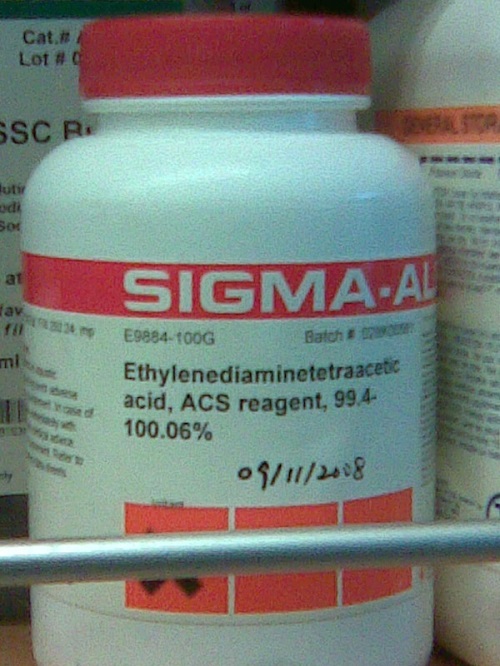Difference Between EDTA and EGTA

EDTA vs. EGTA
Chemistry can be one of the hardest subjects for students in schools. It seems as though most students have developed a detachment from the subject no matter how teachers explain the importance of chemistry in many industries and fields. Then again, students wouldn’t find it difficult to appreciate chemistry if they realized how much weight it bears on the advancement of various industries, especially medicine.
The biggest application of the knowledge acquired from a thorough study and understanding of the chemical processes in the field of medicine is probably the procedures that include ethylenediaminetetraacetic acid, or EDTA, and or ethylene glycol tetraacetic acid, or EGTA.
Both components are used in phlebotomy and in preserving samples of patients’ body fluids. More often than not, nonetheless, EDTA is used more than EGTA. This is because of its ability to bind metal ions, which is applicable in the buffering of electrophoresis.
Biologists dedicated to studying DNA and RNA behavior often use EDTA as it is more effective in preventing the enzymes of DNA or RNA from degrading. In theory, EDTA “freezes” any activity of the enzyme by chelating the magnesium ions, which are known to trigger the activeness of the enzymes. Using EDTA does not affect enzyme activity, but it generally halts their natural activity and allows for the requirement of calcium ions to be determined.
EDTA is also known to have applications in providing an immediate cure to metal poisoning. The food industry also utilizes EDTA as a preservative.
EGTA is as useful as EDTA in phlebotomy. It is known to be a chelating agent like EDTA, but EGTA works through preferentially binding to calcium ions. Most phlebotomists and specialists alike use EGTA to chelate calcium ions under a fully equipped laboratory during cell-based experiments.
Generally, however, EDTA and EGTA are by nature two similar substances. These two acids are comprised of polyamino carboxylic acids and appear to be white crystalline powders when used in laboratory experiments. They both work by binding certain kinds of molecules. Looking through their chemical makeup, their reactions upon exposure to certain molecules and their applications, nonetheless, can draw their differences.
EGTA being able to bind calcium ions contains more carbon, hydrogen, and oxygen than EDTA. EGTA has 14 atoms of carbon, 24 atoms of hydrogen, 10 atoms of oxygen, and 2 nitrogen atoms. This creates the chemical makeup of EGTA, C14 H24N2O10.
EDTA, on the other hand, only contains 10 atoms of carbon, 16 atoms of hydrogen, 8 atoms of oxygen and 2 nitrogen atoms, making its chemical makeup take the form of C10 H16N2O8.
As mentioned earlier, the two acids can be utilized as a chelating agent. Nonetheless, EDTA and EGTA don’t bind the same way. EGTA can be more suitable to be used with a divalent calcium cation. EDTA, on the other hand, is observed to be more attracted to a divalent magnesium cation. Thus, the utilization of these two acids will greatly depend on the substances on which they will be used for lab experiments.
Chemists, phlebotomists, and other scientists have also recorded a higher boiling point of EGTA in comparison to EDTA. At 769 millimeters of mercury (mm. of Hg), EGTA boils at 678 degrees Celsius. With the same exposure to atmospheric pressure, EDTA has been observed to boil only at 614.186 degrees Celsius.
It then follows that EGTA’s flash point is higher than EDTA’s at 363.9 degrees Celsius (for EGTA) compared to a mere 325.247 degrees Celsius (for EDTA). EDTA’s higher density can be accounted for by the lower boiling and flashing point. EDTA weighs 1.566 g/cm3, while EGTA only takes on a mass of 1.433 g/cm3.
Summary:
1.EGTA and EDTA are both chelating agents and appear as white crystalline powders.
2.EGTA is attracted to divalent calcium ions, while EDTA is used for divalent magnesium ions.
3.EDTA has more applications than EGTA.
4.EGTA has a higher boiling and flashing point than EDTA.
5.EDTA is denser than EGTA.
- Differences Between Fraternity And Sorority - January 8, 2014
- Differences Between Lucite and Plastic - January 7, 2014
- Differences Between Oil and Butter - January 6, 2014
Search DifferenceBetween.net :
Leave a Response
References :
[0]http://blog.everydayscientist.com/?cat=27
